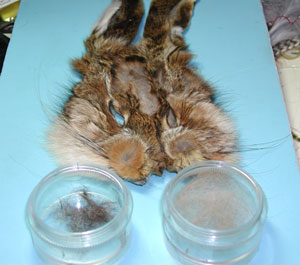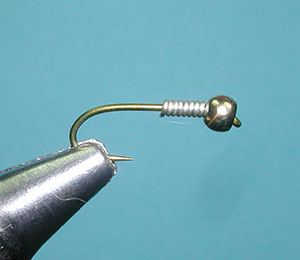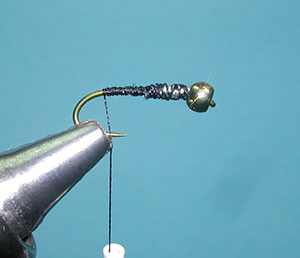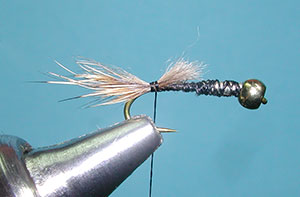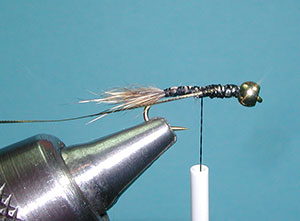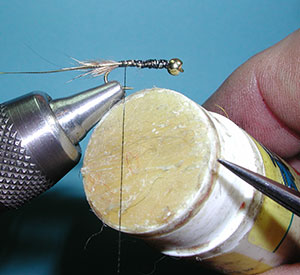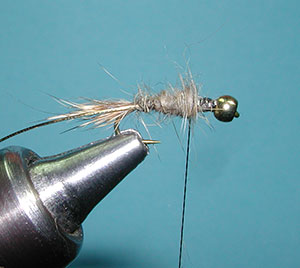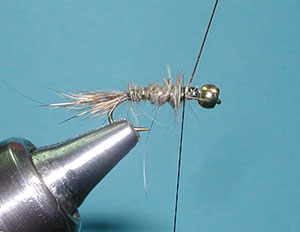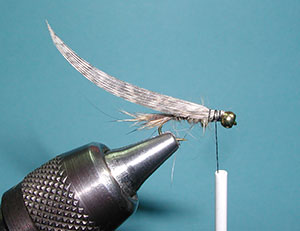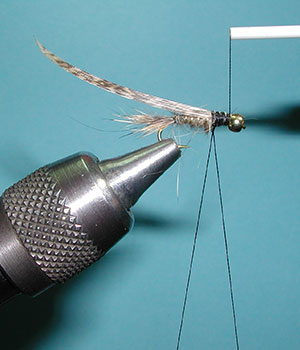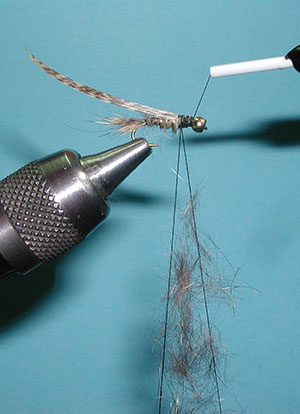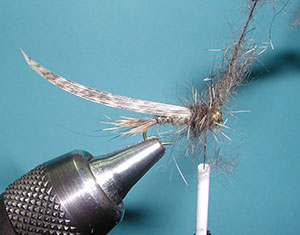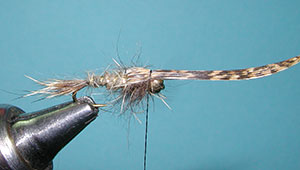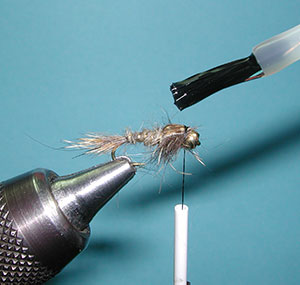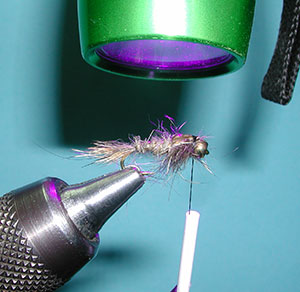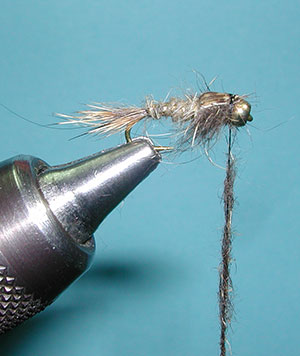Hare’s Ear Nymph – scruffy is better
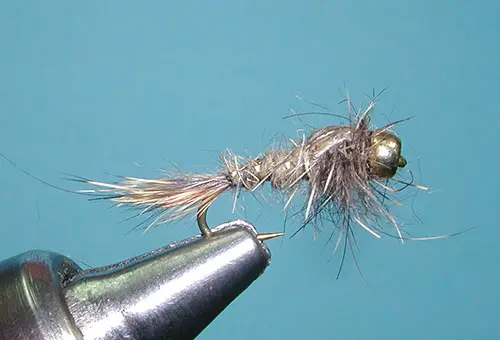
Gold-Ribbed Hares Ear Nymph
Tying Instructions
| Materials
to Order Material, click the link |
|
|---|---|
| Hook | TMC 3761 #10-16 |
| Thread | Danville Black 6/0 |
| Head | Gold Bead |
| Weight | .015 Leadfree Wire |
| Body | Hare's Mask Dubbing |
| Thorax | Hare's Mask Dubbing |
| Tail | Hare's Mask Guard Hairs |
| Wingcase | Mottled Oak Turkey Feather |
| Ribbing | Gold Oval Tinsel |
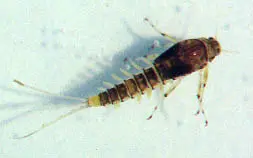
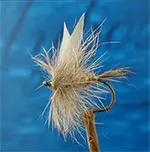
Halford Hare
Hare’s Ear Nymph
The Hare’s Ear Nymph is used widely throughout the world having many variations. No one knows with certainty who originally designed the fly but it is believed that Frederic Halford popularized the pattern in the late 1880s as a dry fly with upright Duck Quill wings and Brown and Grizzly hackles.
The nymph pattern may go back to earlier years of Izaak Walton in 1676 where he describes three patterns tied by Charles Cotton utilizing Hares Ear fur in the 5th edition of Compleat Angler. Although the pattern has a long history, it truly did not become popular until the late 60’s when there was a trend to focus on the use of nymphs in fly fishing.
Most Popular Nymph in the World
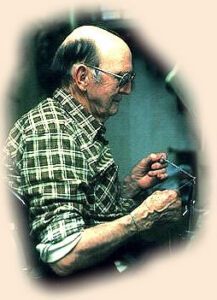
Polly Rosborough
Polly Rosborough wrote about his version in 1969 and Joe Brooks discussed the pattern in 1972. In 1986, Randall Kaufmann stated in The Fly Tyer’s Nymph Manual that; “The Hare Ear Nymph is the most popular nymph pattern in the fly fishing world. It can fished anywhere, anytime, with just about any method and the angler will have a reasonable chance of hooking trout.” The Hare’s Ear Nymph is known as a generic nymph in that it represents many mayfly and caddis nymphs and, therefore, is often used as a searching pattern.
Its shaggy appearance resembles many species of nymphs when they shed their skins or shucks as they progress into the next stage of their life. The occasional long hair coming from the body will assist fooling the trout that your fly is alive as the it moves in the water. The more scruffy this fly is, the better it is at catching fish. Many different colors are used but, primarily in the Sierra, we use natural, tan, brown, and olive. It can be fished either weighted or unweighted.
Hare’s Mask
TheHare’s Maskis the traditional source for the dubbing. The tail is made of guard hairs that are clipped from the area between the eyes of the mask. The underfur is removed by pinching tightly to the guard hairs, keeping them relatively even, and gently pulling away the underfur. The abdomen is made up of hares fur from the cheeks of the mask which is softer and a lighter color than other areas of the mask. This area also tends to have less unruly guard hairs. The thorax is meant to be shaggy and buggy, so I find the best fur to be located on the forehead of the mask. Often the forehead will have darker hair as well. Both the abdomen and thorax dubbing fur should be blended separately prior to tying the pattern.
Not all dubbing is Hare
There are a number of commercial dubbing mixes available but often they use rabbit body fur, not Hare’s mask. Some of these dubbings will also incorporate Antron, Poly, and other materials. The ribbing is often Gold Oval tinsel but, on the smaller sizes, a fine gold wire might work better. This ribbing gives the pattern it’s acronym, GRHE (Gold Ribbed Hares Ear) which you’ll often see posted. Use of a gold bead was a new variation when the beads became available during the 1980’s. Another variation, you will often see is the use of Pheasant Tail fibers, grouse, or hackle fibers for the tail. The GRHE incorporates a wingcase of mottled Turkey but some variations will use Peacock Herl, Pheasant Tail, or Mylar. Turkey can be fragile on this pattern and you will often see an epoxy or cement finish applied upon the wingcase.
Utilizing rubber legs has also been a popular variation to the nymph. The European competition styles will often leave off the bead and leadfree wire weight so that the fly will be the light dropper on a Euro nymphing rig. Some type of hot spot or trigger, like tinsel ribbing, is preferred for these patterns. John Atherton, a prominant fly fisher in the 1930’s and 40’s, added a Kingfisher Blue hackle as a wingcase and this “hot spot” improved the GRHE pattern. He described the pattern in his book, “The Fly and the Fish” (1950).
Presentation
If the fly is greased, it floats and provides an excellent imitation of large, hatching mayflies and caddis fly pupae. The most common method of fishing this popular fly is on a dead drift. The nymph is cast upstream and allowed to drift within the current. This is a most effective short-range technique and takes are usually seen as a splash at the surface. When this fly is immersed, the stiff fibers in the dubbing stand out and imitate the legs of an insect. Fish this lure below the surface with or without a small strike indicator and split-shot to help it sink. The Gold Ribbed Hare’s Ear has also proven it’s effectiveness in lakes. Fished very slowly near the bed of the lake, it is particularly attractive to brown trout.
Wide range of insects
The Gold-Ribbed Hare’s Ear nymph (GRHE) is used to represents a wide range of aquatic insect larvae. The pattern is especially good at representing lighter colored species of mayfly and caddis. It is very useful on still water and moving water for targeting numerous species including amongst others: trout, grayling, panfish, and carp. To imitate darker insect larvae, you might do better with a dyed-black, dyed-brown or dyed-olive variation of the fly pattern.
Variations
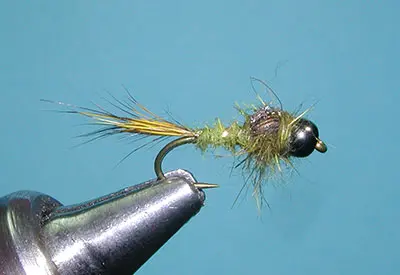
Hare’s Ear Nymph, Olive
| Hook | TMC 3761 #12-18 |
| Thread | Uni-thread Olive 6/0 |
| Head | Black Bead |
| Weight | .015 Leadfree Wire |
| Body | Olive Hare's Mask Dubbing |
| Thorax | Olive Hare's Mask Dubbing |
| Tail | Olive Hare's Mask Guard Hairs |
| Wingcase | Mottled Oak Turkey Feather |
| Ribbing | Gold Oval Tinsel |

Hare’s Ear Nymph, Rubber Leg
| Hook | TMC 3761 #12-16 |
| Thread | Uni-thread Tan 6/0 |
| Head | Gold Bead |
| Weight | .015 Leadfree Wire |
| Body | Bleached Hare's Mask Dubbing |
| Thorax | Bleached Hare's Mask Dubbing |
| Tail | Bleached Hare's Mask Guard Hairs |
| Legs | Ginger Life Flex |
| Wingcase | Mottled Oak Turkey Feather and Pearl Tinsel |
| Ribbing | Gold Oval Tinsel |
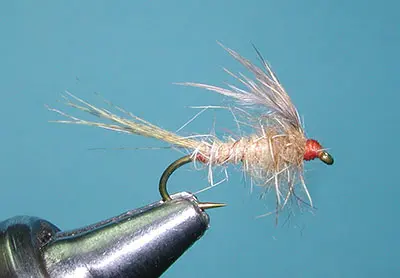
Emergent Hare’s Ear Nymph
| Hook | TMC 3761 #12-18 |
| Thread | Danville Rusty Brown 6/0 |
| Head | Gold Bead |
| Weight | .015 Leadfree Wire |
| Body | Bleached Hare's Mask Dubbing |
| Thorax | Bleached Hare's Mask Dubbing |
| Tail | Mallard Flank dyed Wood Duck |
| Wing | Gray Marabou |
| Ribbing | Small Copper Wire |
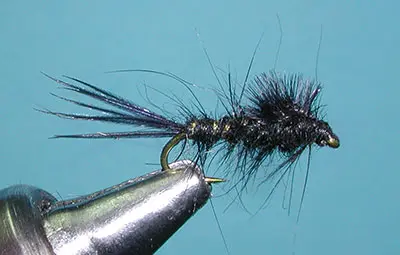
Hare’s Ear Nymph, Black
| Hook | TMC 3761 #12-16 |
| Thread | Danville Black 6/0 |
| Head | Danville Black 6/0 |
| Weight | .015 Leadfree Wire |
| Body | Black Hare's Mask Dubbing |
| Thorax | Black Hare's Mask Dubbing |
| Tail | Black Pheasant Tail fibers |
| Wingcase | Black Ostrich Herl |
| Ribbing | Gold Oval Tinsel |
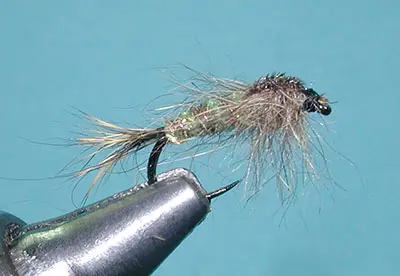
Hare’s Ear European Variant
| Hook | Hanak 230BL #12-16 |
| Thread | Veevus Black 10/0 |
| Head | Gold Bead |
| Weight | .015 Leadfree Wire |
| Body | Bleached Hare's Mask Dubbing and Squirrel Hair Dubbing, Bleached, Blend |
| Thorax | Bleached Hare's Mask Dubbing and Squirrel Hair Dubbing, Bleached, Blend |
| Tail | Hare's Mask Guard Hairs |
| Wingcase | Natural Pheasant Tail with UV Fly Finish Flow |
| Ribbing | Midge Diamond Braid, Oliveand Copper Wire |
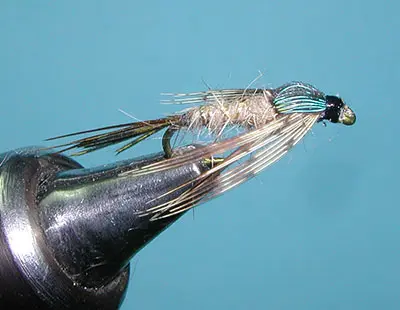
Atherton Medium
| Hook | TMC 3761 #12-16 |
| Thread | Danville Black 6/0 |
| Head | Danville Black 6/0 |
| Weight | .015 Leadfree Wire |
| Body | Hare's Mask Dubbing |
| Thorax | Hare's Mask Dubbing |
| Tail | Natural Pheasant Tail fibers |
| Legs | Natural Brown Partridge Flank fibers |
| Wingcase | Silver Pheasant Silver Doctor Blue |
| Ribbing | Gold Oval Tinsel |

